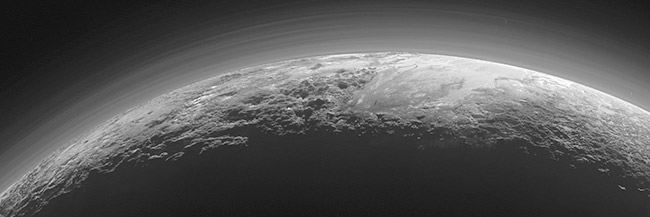NASA Releases HD Pictures of Pluto
 NASA/JHUAPL/SwRI, Public domain, via Wikimedia Commons
NASA/JHUAPL/SwRI, Public domain, via Wikimedia Commons
The first high-definition pictures of Pluto have now been slowly sent back from New Horizons since its closest approach to the dwarf planet in July of this year (2015). But these recent images show off the icy surface like no other and truly gives us “Earthlings” a spectacular glimpse of what Pluto is all about.
According to John Grunsfeld, a former astronaut and associate administrator for NASA’s Science Mission Directorate, he says;
“These close-up images, showing the diversity of terrain on Pluto, demonstrate the power of our robotic planetary explorers to return intriguing data to scientists back here on planet Earth.”
These spectacular pics show a wide variety of terrain including craters, glaciers and mountains. Unlike the other pictures of Pluto, these new images are in HD of about 250-280 feet (77-85 meters) per pixel, which in layman’s terms is about less than half a city block-size on the diverse surface of Pluto — these images are six times better!
“New Horizons thrilled us during the July flyby with the first close images of Pluto, and as the spacecraft transmits the treasure trove of images in its on board memory back to us, we continue to be amazed by what we see,” quips Grunsfeld.
These images were taken by the LORRI (Long Range Reconnaissance Imager) on board the New Horizons spacecraft over a one minute time-span on July 14th, 2015 from a distance of about 10,000 miles (17,000 kilometers). The below image shows the great blocks of Pluto’s water-ice crust which appear jammed together in the informally named al-Idrisi mountains.
NASA/Johns Hopkins University Applied Physics Laboratory/Southwest Research Institute, Public domain, via Wikimedia Commons
Why are these higher resolution than previous images?
The New Horizons team explains these were obtained using a different observing mode one using the LORRI to snap pictures every three seconds, rather than a point-and-shoot method. Then the Ralph/Multispectral Visual Imaging Camera (MVIC) (also aboard New Horizons) began scanning the surface, which allows for unusually short exposures to avoid blurring the images.
This video shows the put together images taken from a 50 mile (80 kilometer) strip of Pluto’s surface, about 500 miles (800 kilometers) northwest of the “Sputnik Planum” which is across from the al-Idrisi mountains.
More pictures are expected to be sent back in the coming months, so we can really get a clear definition of what Pluto has been hiding all these years. With all this wonderful technology now available to us, we are sure to unlock the many mysteries of Pluto (and hopefully other planets) that we could only dream of before.
